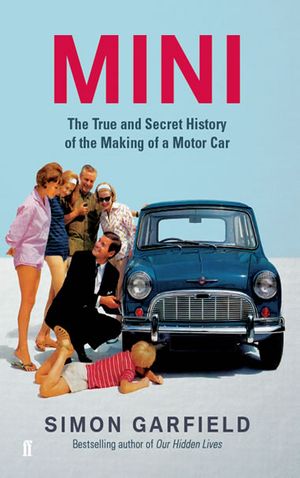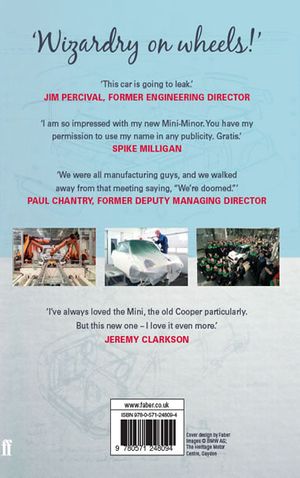Mini
Mini
About the book
In the summer of 2008, I received an email from a woman who worked for BMW. The Mini would be 50 in May of the following year, and perhaps there was a book in it? Of course there was a book in it: there were about 50 books in it.
I went to see the people at the MINI plant at Cowley, near Oxford, the same place they’d made the car at the beginning. They didn’t quite know what they wanted, but they knew what they didn’t want. They didn’t want something dull and official; a lot of corporate histories had been written about cars and their factories, and many were unreadable. They didn’t want something about Twiggy and swinging London, or about blowing the bloody doors off – there were books like that, and very fine they looked too, but why print the same pictures and stories?
So I came up with a plan, and the book that emerged isn’t too far from the original synopsis. The book is about the people who made the car in 1959 and 2009, some of whom have grand titles and some of whom do not. The thinking was: talk to the engineers, managers, assembly-line workers and marketing people, and I might get quite close to the soul of the car.
The Mini (original version) and the MINI (new version) are, of course, not like any other motor. They have a history and ethos that is not only unique, but also a surprising one. When the first Mini was sold in 1959, no one – not even its egomaniacal designer – guessed what a thing it would become: more than a car. People would talk of it not only as a means of transport but as a lifestyle and an attitude. People would think of the car and smile. How could this be? Why would marketing people claim that more drivers gave their Mini a name than any other car? How would a thin box of metal and wires become a welcome and indulged part of a human family?
The Mini of old is not the MINI of today – thank God. Its single greatest achievement – popularising the idea that smallness and not bulk is desirable – has held fast through half a century of great turbulence in the British car industry, and it may be the only constant. The car has improved beyond measure. It has a new style, a new size, a new price, but it maintains strong links with the past not just through its factory but through its ethos. It is no longer British, but this is not uppermost in the minds of the hundreds of Poles and Turks and Greeks and Ukrainians and Irish who turn up each day to build it.
As I write in the book’s preface, making a car was not the task it once was. I had heard stories about Dante’s Inferno, of oil slicks beneath men’s feet, of industrial fatalities.
Cars had been built at Cowley for almost a hundred years, and amidst the grease and infernal clatter it concealed the most romantic story. This is where the great motor-car builder William Morris set up shop, where the cars of our parents and grandparents were made. It was where hundreds of thousands of people spent a lifetime welding metal together. And it was where the Mini reinvented itself as the MINI.
Born out of an economic and political crisis, it celebrates its fiftieth birthday during another one; once more it may be the best car for its time. When I turned up at the plant in 2008, it became clear that alongside the engineering and techno- logical feats lay a tale of immense human endeavour, and I hoped that perhaps an oral narrative assembly line could reveal new truths. The people I spoke to tell the story as best as they can remember it, and because the story of the Mini old and new means so much to them, they tend to remember it vividly and with great affection. I do wonder whether any other car has ever been so intensely fought for, or so wildly loved.
Extract from Chapter 1
1 ‘This car is going to leak,’ said Jim Percival
Peter Tothill (production engineer)
Towards the end of 1957, Leslie Ford, the chief planning engineer, called me into his office and said, ‘There is a new highly secret model coming, and I want you to deal with it from scratch. I will take you over to E Block paintshop and show you where we will build it.’
We entered the south-east corner of the building and there was a vast area of pristine concrete floor.
So where the hell do I start?
Roy Davies(vehicle proving engineer)
Early in 1958, a prototype Mini appeared in the chassis experimental department next door to the drawing office where I worked. It was quickly locked away in a cabin, and access was only allowed to authorised persons. The cabin was guarded by
a works policeman.
Peter Tothill
The next task was to get some idea of the car. It was coded ADO15 (Austin Drawing Office, project 15) but already nicknamed Sputnik. I had already seen this strange little vehicle with wheels the size of shirt buttons. It was Prototype No. 1, and was being endurance-tested round and round Chalgrove aerodrome, south-east of Oxford.
Roy Davies
The Mini was called Sputnik because at the time they started doing the testing round Chalgrove, the Russians had just put the Sputnik in the air, an orange thing going round the sky. At night, the Mini going round Chalgrove was an orange thing going
round on the ground. The road-proving engineers christened it Sputnik much to Issigonis’s disgust. In later years he had a change of memory and said that he christened it, but he didn’t.
Alec Issigonis (designer)
At that time, Leonard Lord [chairman of the British Motor Corporation] got me to design a car to beat these bubble cars.
Alex Moulton (suspension engineer)
He’d been called Arrogonis.
Alec Issigonis
Oh yes, I’m Arrogonis!
Leonard Lord gave me completely carte blanche to do what I wanted to do, except one thing. He said, ‘Alec, you can do whatever you like, but it’s got to have an existing engine that is now in production.’
Lord Stokes (chairman, British Leyland)
Alec Issigonis, as you know, a very great man, a very charming man, one of the most charming men you could possibly meet, but he was also – and this is why he succeeded I suppose – a very dominant engineer.
Alec Issigonis
Lord got in the [prototype] with me and I took him round the block at Longbridge as fast as I could – they’ve got a big circuit at the works – and I almost frightened him I think. We stopped outside his office, and he said, ‘Alec, I want it made in a year’s
time. Get going.’
Peter Tothill
So the next thing that happened was we were loaned Prototype No. 3 to strip and rebuild and we had a little compartment built, the cabin, in the experimental department, out of plywood sheets so that we could do it in some secrecy. We were a
bit vulnerable from the press because the way the bypass was built, you could see right into the factory from the ramp. Our cabin was built over a pit area so we could get underneath.
There was a small team of us, and we had a week to strip and rebuild this car, so we did that and I made endless notes, problems or potential problems. Issigonis – I may appear very critical of Issigonis, which I am in a lot of ways – but one of the things he decided, and he convinced the board, was that you didn’t need a vast engineering organisation. Now Issigonis was a brilliant innovator, absolutely first-class innovator, but he had no time for the nitty-gritty detail. He just used to say, ‘Solve it, don’t come to me, just solve it.’
Alec Issigonis
I design cars without any prompting from my employers to suit what they want for sale. I thought I knew better than the market-research people what the public wanted. As is shown in the results.
Roy Davies
The thing that rolled through the Mini was the water leak fiasco.
Issigonis for a long time would not admit that there was a water leak, despite the fact that his Mini had a pair of wellingtons constantly in the boot for him to wear. The basic problem was, if Issi had designed a house, he would have put the tiles on
upside down. When he designed the Mini floor, he insisted on having it so that the water went up. Instead of having the floor like that [hands curved upwards] he insisted on it being that way [facing down], so the water just went into the car.
The boys at Nuffield Metal Products who make the bodies and the people at the Fisher division who make the bodies all said, ‘It’s not sealable.’ It took Issigonis about eight or nine months to acknowledge that it wasn’t sealable.
Peter Tothill
Before we’d even started building I went up to a meeting in Birmingham at Nuffield Metal Products who built the bodies for Morris. My understanding was that the only purpose of the meeting was to establish in detail how they were going to ship
the body to Cowley, what would be fitted, what wouldn’t be fitted. After the meeting ended, a guy called Jim Percival, who was the engineering director, said, ‘Right, I want to talk to you.’ I thought, what have I done wrong? He said, ‘I want you
to talk to your boss Leslie Ford when you get back. I’ve already told him, but I want you to reinforce it: this car is going to leak.’ So I thought, well, why don’t you bloody well change it?
He said, ‘I’ve had three acrimonious meetings with Issigonis and he will not change the design of the body. He’s done it according to him; he’s done it for ease of assembly. I’ve argued with him that it doesn’t make it any easier to assemble, but it
does guarantee it will leak.’ Issigonis insisted on it being like that, so that any water coming off the front wheels went straight [up into the floor], and the pressure of it coming off it was like coming out of a fire-hose jet. ‘When it comes off the wheel it will wash any sealant out and it’ll leak. And there’s another place in the front wheel arch,’ he said, ‘where once it’s got past the sub-assembly stage you can’t get at it to seal it.’ He said, ‘I want you to impress this on Leslie Ford.’ Fine. I did that and Leslie Ford reported it up through the process but didn’t get anywhere with Issi.
Roy Davies
What was interesting, it was conceived really because of the Suez Crisis and so forth, and yet the take-up by the public was initially very low. But at the car factory it made an immediate impression on you. Because [before it] there was the Morris Minor and the Morris Oxford. Before that was the Morris Six, which was a big Morris Oxford with a longer bonnet. And the Wolseley Six was a Morris Six with a different front end on it. We’d always grown this family of cars, but the Mini was almost like dropping a Ford Escort into the place. It was immediately different. The shape instantly gelled. The shape looked right – it was a complete car.
Read the full extract .pdf format (52kb)


